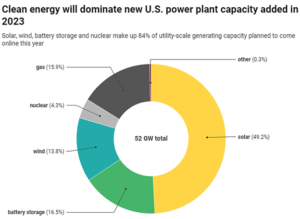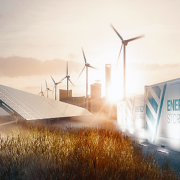Hawaii Falls Behind National Transition to Clean Energy

Clean energy is crushing the competition to supply new power plants for the U.S. this year, except perhaps for Hawaii’s political pursuit of last century energy options (combustion polluting power plants), as in burning trees and waste / trash for energy.
Based on January data from the U.S. Energy Information Administration, clean energy will dominate new US power capacity in 2023 with Solar, Wind, and Batteries leading the way and accounting for nearly all new power plant construction.
The star of the show is Solar
This abundant clean energy resource has risen from the margins of the utility sector to make up roughly half of the new planned capacity in 2023. Meanwhile, rooftop solar has returned as the leading self-powered energy security option addition for commercial and residential buildings, with this energy sector enjoying a rapid recovery from previous Covid-related supply issues.
Of course, solar plants don’t produce around the clock the way gas, oil, or nuclear can. That limitation is driving the surge in battery installations to store surplus solar and wind production for use as needed (firm) and when it’s more valuable.
Batteries can also be charged from the grid, especially as EV adoption increases, and clean power adoption offers the additional benefit and role of off-setting increased electricity demand and the potential for added grid-generated greenhouse gas emissions in transition to ground transportation electrification.
Meanwhile, battery storage is beating out gas (primary mainland energy source for so-called peaker plants), and representing for the first time batteries displacing combustion energy options in the role of meeting “firm energy” needs for utilities — Senator Dela Cruz (HI) infamous and incorrect statements of 4 hour battery limitations is as out-of-date as his energy agenda for the state.
Hawaii’s Energy Politics
Undeterred from his political loses of 2022, with Governor Ige’s veto of SB 2510 and 2511, were bills rammed through the political process mandating the burning of trees and trash for power. Senator Dela Cruz and his political allies misguided dirty energy priorities for Hawaii’s energy future remain steadfast, and unenlightened.
During the current 2023 legislative session, Senator Dela Cruz flexed his political muscle once again with an energy agenda that includes support of SB-72 designed to cripple Hawaii’s PUC due diligence process (in representing ratepayer interests) of non-compliant dirty energy applications which come before the Commission. He is also pushed SB 817 through the Senate, which amends the definition of “eligible business activity” within the state’s enterprise zones to produce (with taxpayer funding), dirty energy feed-stocks for biomass-burning power plants.
Another example of how outdated and expensive combustion (burn) power sources can’t complete with zero emissions / clean energy alternatives is how solar plus battery plants consistently come in at less than half the cost of biomass burn-generated energy, even as those biomass plants will enjoy public subsidies and waivers from state rules. The poster child for this insult to injury to the public interest is best exemplified by another Dela Cruz energy agenda item; his unwavering support of the infamous and discredited Hu Honua biomass plant (see previous BeyondKona coverage of this failed power plant proposal).
As of today, with the state Supreme Court determination in a clear cut 5-0 decision, rendered on March 13th, resulting in Hu Honua suffering it greatest legal loss to date — in what has been as a bad deal for the residents and ratepayers of Hawaii Island from the first day one it was proposed. The Hawaii Supreme Court decision denied Hu Honua’s appeal of a previous Public Utilities Commission decision citing several areas in which Hu Honua repeatedly failed to satisfy basic requirements.
Every biomass plant (trees and trash burned for energy) allowed to go forward blocks a clean and renewable energy plant, available at lower energy cost to ratepayers, and ready to take Hawaii to clean, renewable, and yes, sustainable energy future.
Beyond Hawaii; it’s all about market forces, clean-power climate mitigation, ratepayers priorities
Fossil-fueled plants are expected to make up just 16 percent of new capacity additions completed in 2023, based on January data from the U.S. Energy Information Administration. Adding more fossil-fuel power plants to the national grid is rapidly becoming a utility-driven decision practice of the past. It is likely, based on present trends, there will be no new fossil plants built in the US within the next 10 years. And most people look forward to the inevitability of that day when it comes.
Carbon-free power plants are on track to deliver 84 percent of new capacity — that includes solar, wind, nuclear, and battery storage. That’s a larger share than last year, when clean power plants made up 78 percent of new capacity.
Clean and renewable energy still represents a smaller share of the nation’s total electricity production. But this snapshot of the power industry in 2023 (outside of Hawaii) shows that clean energy is already set to be the dominant choice for new power plants, seizing that mantle from fossil fuel gas plants.
It’s also a coup for battery storage, which went from extremely fringe just a few years ago to the second-place spot for new capacity coming online this year.




Excellent article. The HI legislature needs a good house cleaning (and senate cleaning)! Dela Cruz, Wakai, Inouye, and others attempting to do legislative favors for Hu Honua at the expense of taxpayers, ratepayers, and anyone wanting a livable climate – need to be shown the exit.
Our legislature and our clean energy transition has been arrogantly corrupted by their dirty deeds.